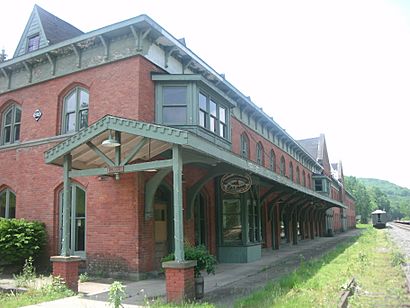Susquehanna station facts for kids
Quick facts for kids
Susquehanna
|
||||||||||||||||||
|---|---|---|---|---|---|---|---|---|---|---|---|---|---|---|---|---|---|---|

The station depot at Susquehanna, as seen in May 2011, from the Pavonia Terminal-bound track, 148 years after construction of the depot.
|
||||||||||||||||||
| Coordinates | 41°56′41.1″N 75°36′34.9″W / 41.944750°N 75.609694°W | |||||||||||||||||
| Owned by | Erie Railroad (1851–1960)
Erie Lackawanna Railroad (1960–1976) Conrail |
|||||||||||||||||
| Line(s) | Main Line (Mahoning Division) Mahoning Division First Sub-Division |
|||||||||||||||||
| Platforms | 1 side platform | |||||||||||||||||
| Tracks | 2 | |||||||||||||||||
| Other information | ||||||||||||||||||
| Station code | 3303 | |||||||||||||||||
| History | ||||||||||||||||||
| Opened | 1851 | |||||||||||||||||
| Closed | January 6, 1970 | |||||||||||||||||
| Rebuilt | 1863 | |||||||||||||||||
| Former services | ||||||||||||||||||
|
||||||||||||||||||
The Erie Railroad Station in Susquehanna, Pennsylvania, was a very important building for the Erie Railroad. It was built in 1863 and had a special design called Gothic Revival. This large, three-story building was not just a train station. It also had a big hotel called Starrucca House.
The Starrucca House could host 200 people. It had a dining room that was about 120 feet (37 meters) long. The whole building was about 327 feet (100 meters) long and 40 feet (12 meters) wide. Around 1903, the railroad changed the hotel part into offices and sleeping areas for its workers. The building was updated again in 1913 and 1917.
The Erie Railroad later joined with another company to form the Erie Lackawanna Railroad in 1960. Passenger train service through Susquehanna stopped in 1966. The very last passenger trains left on January 6, 1970. The station was added to the National Register of Historic Places in 1972 because of its historical importance.
Contents
A Look Back: The Station's Story
How the Railroad Came to Susquehanna
The railroad company, then called the New York, Lake Erie and Western Railway, built its tracks through a thick forest in 1848. They chose this spot as a main center for their work between Piermont and Dunkirk, New York. At that time, the area had no name and only one farm nearby. The railroad bought 300 acres (121 hectares) of land along the Susquehanna River. They planned to build repair shops and other important buildings there.
The new facilities in Susquehanna included a huge machine shop. It was about 774 feet (236 meters) long and 138 feet (42 meters) wide. This shop could hold up to 40 train engines! There were also shops for boilers, blacksmiths, painting, and a foundry. The area even had a large hall for workers to learn and meet, which could fit 600 people.
The Starrucca House Hotel
The Erie Railroad also built the Starrucca House. This building was a hotel for train passengers. Its dining hall was 120 feet (37 meters) long and 40 feet (12 meters) wide. The hotel was important because trains coming from Gulf Summit, New York had to stop here. The tracks from Gulf Summit had a very steep hill, so engines needed a break.
The Starrucca House could feed and house 200 people. It was the first train station building in the United States made entirely of brick. It even had a library with 2,400 books, a reading room, and the lecture hall for workers. By 1863, the shops in Susquehanna employed 700 men. This was a big jump from the original 350 workers. Their average salary was $38,000 per year. James Gregg, the main mechanic, worked to make the shops better and safer from fires. New shops were built that year, costing about $1.25 million (in 1865 money). They also bought $500,000 worth of tools and machines for the 8 acres (3.2 hectares) of land.
The Workers' Strike of 1874
In March 1874, the Erie Railroad fell behind on paying its workers at the Susquehanna shops. On March 15, the railroad said they would pay, but then announced they had to delay it until March 25. The workers agreed to wait. However, they said they would stop working on March 25 if they weren't paid.
On March 25, the railroad said they had to pay other workers first. Because they didn't get their wages, the shop workers told the managers to leave. The workers then took control of the facilities. They demanded payment within 24 hours. If not, they would stop trains from running.
The railroad fired the strike leaders, which made things worse. The shop workers made train engines unable to move. They put them in a roundhouse and left coal and fuel cars on side tracks. Workers even hid parts of the engines in town. Many people, including the media and government, supported the workers. The local Sheriff, M.M. Helme, refused to make the workers leave the property. The Governor of Pennsylvania, John F. Hartranft, said that only the Sheriff could ask for state troops. The Sheriff and other important people in the village refused to do so.
The railroad's lawyers soon realized that trains were being stopped down the line. This caused Sheriff Helme to finally call for troops. The railroad offered to give all but the strike leaders their jobs back if the strike ended. The workers said no. With that, the railroad threatened to move their shops to Elmira, New York. This would hurt the local economy a lot. This threat made the workers' support weaken. The strike ended within hours, and workers returned to their jobs.
Images for kids


